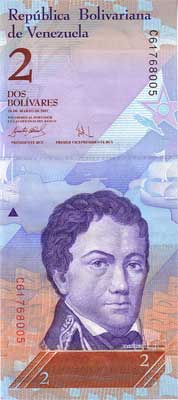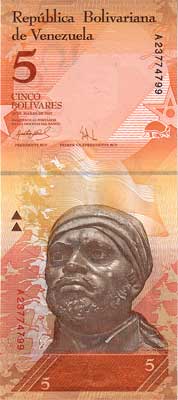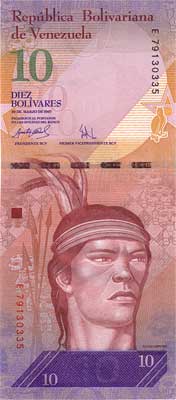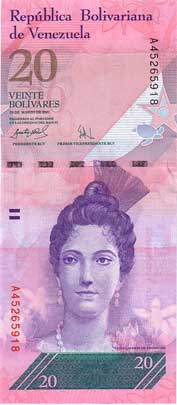 | Pick# 88 - Banco Central de Venezuela 2 Bolívares Note
Obverse: Generalísimo Francisco de Miranda, Venezuelan flags, sailing ships, dolphin, red, yellow and blue UV fluorescent fibers
Reverse: Pink Amazon River Dolphins (Inia geoffrensis), Gusano Flor (Worm Flower), Parque Nacional Médanos de Coro (Coro Dunes National Park, worm flower, arms at center right
Watermark: Watermark: Portrait of Francisco de Miranda
Printer: Casa de la Moneda, Venezuela
Size: 156 x 69 mmSebastián Francisco de Miranda y Rodríguez (Caracas, March 28, 1750 - in prison, El Arsenal de la Carraca, Cadiz, July 14, 1816), commonly known as Francisco de Miranda, was a Venezuelan revolutionary. Although his own plans for the independence of the Spanish American colonies failed, he is regarded as a forerunner of Simón Bolívar, who during the Hispanic American wars of independence successfully liberated a vast portion of South America. Miranda led a romantic and adventurous life. An idealist, he developed a visionary plan to liberate and unify all of Spanish America but his own military initiatives on behalf of an independent Spanish America failed in 1812. He was handed over to his enemies and four years later, in 1816, died in a Spanish prison. Within fourteen years of his death, however, most of Spanish America was independent.
The portrait of the Generalissimo Francisco de Miranda is a copy of the original Georges Rouget produced by Charles Ventrillon-Horber The reverse side of the note portrays endangered animals to raise awareness about the conservation and respect for national diversity.
The "Amazon River Dolphin" is found from Venezuela to Peru and is considered the largest freshwater cetacean in the world. In Venezuela it can be seen in the Orinoco basin, and Casiquiare and Black rivers. The main threat to its survival is construction of hydroelectric dams in its habitat, which split their stocks and interferes with gene flow between them.
Parque Nacional Médanos de Coro (Coro Dunes National Park) was declared on 6 February 1974. The park's territory includes the isthmus that bears it's name in the state of Falcon. Its formation is due to the constant trade winds usually blow from east to west. This park is one of the most important natural representations Venezuelan landscape.
Gusano Flor (Worm Flower) is marine species belonging to the family of polychaetes. It an be found in the Caribbean Sea, Pacific Ocean and Atlantic Ocean, on hard substrates such as rocks and corals, piers and boat hulls>
|
 | Pick# 89 - Banco Central de Venezuela 5 Bolívares Note
Obverse: Pedro Camejo - El Negro Primero, charging horsemen, Venezuelan flag, red, yellow and blue UV fluorescent fibers
Reverse: Giant Armadillo, Tatou, Ocarro, Tatú Carreta (Priodontes maximus), Cuspón o Cachicamo Gigante, towering palm trees in Los Llanos (The Flat Plains) — one of the most beautiful regions in Venezuela
Watermark: Portrait of Pedro Camejo
Printer: Casa de la Moneda, Venezuela
Size: 156 x 69 mm |
 | Pick# 90 - Banco Central de Venezuela 10 Bolívares Note
Obverse: Cacique Guaicaipuro, spears, masks, red, yellow and blue UV fluorescent fibers
Reverse: Harpy eagle, Águila Arpía (Harpia harpyja), Salto Ucaima y tepuyes Venado y Kurún (Parque Nacional Canaima)
Watermark: Portrait of Cacique Guaicaipuro
Printer: Casa de la Moneda, Venezuela
Size: 156 x 69 mm |
 | Pick# 91 - Banco Central de Venezuela 20 Bolívares Note
Obverse: Luisa Cáceres de Arismendi, red, yellow and blue UV fluorescent fibers
Reverse:: Critically endangered Hawksbill Turtle, Tortuga Carey (Eretmochelys imbricata); Montañas de Macanao (Parque Nacional Laguna de la Restinga)
Watermark: Portrait of Luisa Cáceres de Arismendi
Printer: Casa de la Moneda, Venezuela
Size: 158 x 69 mmLuisa Cáceres de Arismendi was born in Caracas on 25 September 1799. She was the wife of the military and patriot leader Juan Bautista Arismendi. She was arrested by the royalists as a means of extortion to her husband, and she remained in captivity and exile for 3 years. She staunchly supported the patriot cause and her husband, despite the hardships suffered during her confinement. She died in Caracas in 1866, and her remains were transferred to the Pantheon National on 24 August 1876.
The Portrait of Luisa Cáceres de Arismendi, is an oil on canvas painting by Emilio Jacinto Mauri circa 1899. The reverse side of the note portrays endangered animals to raise awareness about the conservation and respect for national diversity.
The Hawksbill Turtle (Eretmochelys imbricata) inhabits shallow tropical waters on rock or coral. They lay their eggs on land, and their nesting areas are in the Archipelago of Los Roques and the Blanquilla Island. The turtle populations are threatened by hunters. |
 Venezuela Paper Money Collection
Venezuela Paper Money Collection Venezuela Paper Money Collection
Venezuela Paper Money Collection